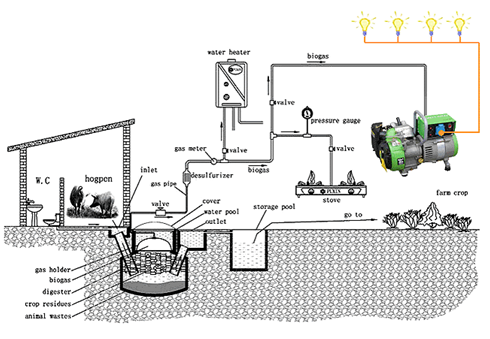Click here to register!
Difference between revisions of "Electricity Generation from Biogas"
***** (***** | *****) m |
***** (***** | *****) m |
||
| Line 26: | Line 26: | ||
Theoretically, biogas can be converted directly into electricity using a fuel cell. However, very clean gas and an expensive fuel cell are necessary for this process. This is therefore still a matter for research and is currently not a practical option. | Theoretically, biogas can be converted directly into electricity using a fuel cell. However, very clean gas and an expensive fuel cell are necessary for this process. This is therefore still a matter for research and is currently not a practical option. | ||
| + | |||
| + | |||
| + | [[File:Biogas plant used for power generation.png]] | ||
| + | |||
<br> | <br> | ||
Revision as of 12:27, 17 November 2010
Introduction
Biogas technology, the generation of a combustible gas from anaerobic biomass digestion, is a well-known technology. There are already millions of biogas plants in operation throughout the world.
Whereas using the gas for direct combustion in household stoves or gas lamps is common, producing electricity from biogas is still relatively rare in most developing countries. In Ger-many and other industrialised countries, power generation is the main purpose of biogas plants; conversion of biogas to electricity has become a standard technology.
This document will discuss the potentials, obstacles and necessary framework conditions for the utilisation of biogas for small and medium scale electricity generation in developing coun-tries. This paper will not address the biogas production process in general but focus uniquely on electricity generation.
The findings presented here are based mainly on available experience from GTZ-related pilot biogas power plants in different countries. They focus on more or less well-documented ex-isting country cases even though little extensive documentation of practical long term operat-ing experience is available. Besides the cases described here, we know of further examples from other GTZ projects (e.g. Bolivia, Tunisia and the Ivory Coast). However, there is not yet sufficient information concerning these to merit inclusion in this assessment.
The Technology
Biogas is gas resulting from an anaerobic digestion process. A biogas plant can convert ani-mal manure, green plants, waste from agro industry and slaughterhouses into combustible gas. For further information on the biogas production and fermentation process please refer to the Biogas Portal on Energypedia.info: http://www.energypedia.info/index.php/Portal:Biogas
Biogas can be used in similar ways to natural gas in gas stoves, lamps or as fuel for engines. It consists of 50-75% methane, 25-45% carbon dioxide, 2-8% water vapour and traces of O2 N2, NH3 H2 H2S. Compare this with natural gas, which contains 80 to 90% methane. The en-ergy content of the gas depends mainly on its methane content. High methane content is therefore desirable. A certain carbon dioxide and water vapour content is unavoidable, but sulphur content must be minimised - particularly for use in engines.
The average calorific value of biogas is about 21-23.5 MJ/m³, so that 1 m³ of biogas corre-sponds to 0.5-0.6 l diesel fuel or about 6 kWh (FNR, 2009).
The biogas yield of a plant depends not only on the type of feedstock, but also on the plant design, fermentation temperature and retention time. Maize silage for example - a common feedstock in Germany - yields about 8 times more biogas per tonne than cow manure.
In Germany, cow manure and energy crops are the main forms of feedstock. About 2 live-stock units (corresponding to about 2 cows or 12 rearing pigs) plus 1 ha of maize and grass are expected to yield a constant output of about 2 kWel (48kWhel per day).
In the South Asian context, ESMAP uses a typical specific input-output relation of about 14 kg of fresh cattle dung (the approximate production of one cow on one day) plus 0.06 l diesel fuel to produce 1kWh electricity.
Conversion to Electricity
Theoretically, biogas can be converted directly into electricity using a fuel cell. However, very clean gas and an expensive fuel cell are necessary for this process. This is therefore still a matter for research and is currently not a practical option.




















